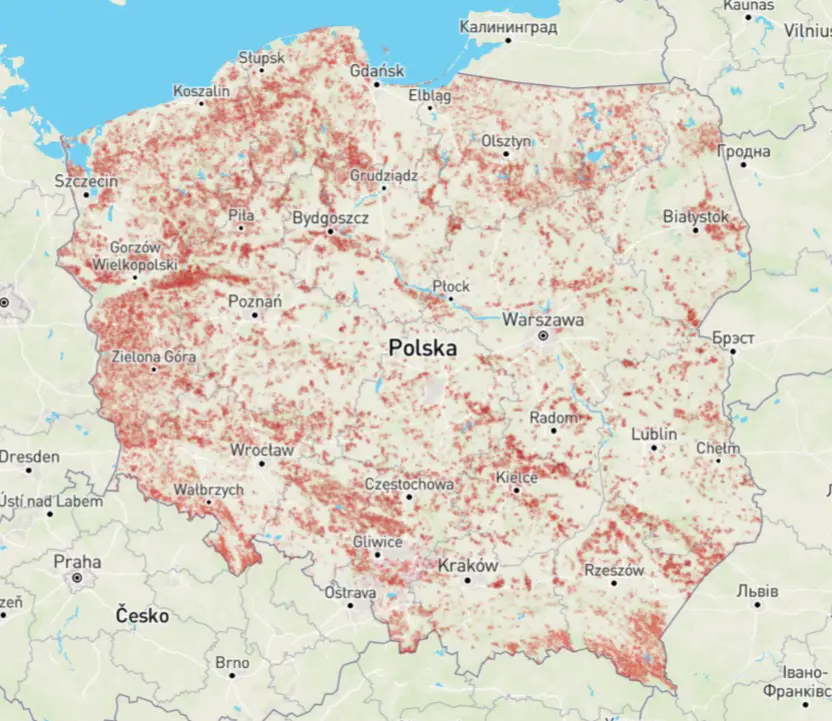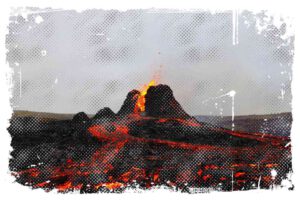Forests and woods cover more than a quarter of Poland’s territory. They play an important role in protecting us from the negative effects of climate change, including droughts, floods, and heat. So, it’s important to protect them.

Unfortunately, in recent years, there has been a lot of logging in Polish forests. This has led to a lot of controversy, especially since deforestation takes place in suburban forests, landscape parks, and reserves, as well as in primeval forests.
Extent of Deforestation in Poland – Statistics and Trends
When it comes to statistics, the number of cubic meters of trees cut down in Polish forests has been steadily increasing over the past 20 years. It used to be 25 million cubic meters of wood, and now it’s up to 40 million cubic meters per year.
Let me present to you an initiative called „Forests and Citizens”. They created a map that shows which parts of the forests will be cut down. They made it using publicly available information from the State Forest Data Bank, which was made public in January 2021. The map showed areas where logging is planned, marked in red. Take a look at this for yourself below.
↳ PRO TIP: Do you like traveling? Then before you buy any ticket or book an attraction, check if it's available in this worldwide Viator Database. You may save a lot of money and time. No need to thank me :)

The Problems In The Wood Industry in Poland
Why do we cut down so many trees? Poland has a high demand for wood. As I already wrote, the annual consumption reaches 40 million cubic meters. This year, that number is expected to increase even more. This is due to the rising cost of coal and gas, which is causing more people to heat their homes with wood. Additionally, Poland is importing less raw material than before, as a result of reduced exports from Ukraine due to the war.
This shortage of wood in the market and in state forests, despite the large scale logging, is not able to meet the demand. This is partly due to the sale of a significant portion of the harvested raw material at auctions. They are open to anyone, which means that a lot of Polish timber is being exported abroad.
Causes of Deforestation in Poland: Export and High Coal Prices
As I already explained, more and more people in Poland use wood for heating their homes. I found an interesting interview with local citizens of southern Poland who explained his individual situation.
In Podhale, more than 80% of all forests are private property. Many of these owners moved there specifically to obtain firewood for the winter. Logging, while not good for the environment, is legal because people are allowed to harvest wood from their own forests. In many cases they do not need official permission to do so.
Interesting fact is, that last year our governemnt encouraged wood burning as a way for Poles to heat their homes. Residents of mountainous areas are not happy with having to cut down their own forests to avoid freezing in winter.
Residents of mountainous areas, having nowhere to buy coal or finding the price too high, have moved to the forests.
It’s no wonder that in a situation where a ton of coal already costs as much as 3,000 zlotys, and gas is also expensive, many people have decided that they must prepare for winter on their own. After all, none of us wants to freeze, right?
The Wood Price is Managed by the State Forests
The State Forests (Lasy Państwowe) in Poland have a monopoly on the timber market. It means they manage wood prices, and every decision they make affects the entire industry.
Recently, the State Forests announced new rules for the sale of raw material for next season, which will make it more expensive. Prices for regular customers will increase by 30–40%. The minimum price of wood at auctions has also been raised by as much as 30%.
The lack of a maximum price restriction and the fact that anyone can participate in the auctions, have allowed Chinese and German entrepreneurs to win the auctions. As a result, it has been more profitable for Polish companies to import wood from Finland or Norway than to buy it from our local national State Forest.
Furniture Exports
The decisions of the State Forests also affect the timber market in terms of exports. Poland is one of the largest furniture exporters in the world, but recent decisions by the State Forests may change that.
Some regional branches of the State Forests have decided not to certify wood with FSC, which is a confirmation that the wood was legally harvested. Wood and related products without such certification cannot be imported into most European Union countries. This has caused the furniture industry to sound the alarm, as the lack of an alternative source of wood means that the cancellation of certificates by the State Forests could limit the furniture exports. That would be a huge blow to the entire Polish furniture industry.
How Specialists Explain the Situation
Experts explain that cutting down trees in the forest is not always a bad thing. Trees, like all living organisms, have a natural lifecycle. The lifespan of a tree depends on the species. The short-living species like willows and poplars reach old age at 40–60 years. Long-living ones like oaks live up to 180 years on average.
The natural process of competition for resources such as water and sunlight also plays a role in the lifecycle of trees. There are always some species that lose the battle at a very young age. Particularly those that require a lot of light. For this reason, logging can be seen as a way to maintain a healthy balance in the forest ecosystem.
People who live in cities or towns may not understand the intricacies of forest ecology and may see logging as a crime against nature. However, it’s worth remembering that the environmental role of trees in forests and woodlots is important, but so is the natural process of their lifecycle.
By the way, please check on my other article about the colors of autumn in poland’s forests. You will learn from it why leafs are brown, yellow or red.
Are There Positive Aspects of Deforestation?
Deforestation in Poland has some positive aspects too. First of all, forests provide us with wood, which is used to create a wide range of products, including paper, furniture, roof trusses, and fuel.
The forest industry provides jobs for over 370,000 people in Poland and we are the sixth largest producer and fourth largest exporter of furniture in the world. This high position is a testament to the quality of Polish-made products. The State Forests are the main supplier of raw material to the domestic market and they cover over 90% of the demand for wood.
Wood, unlike coal and oil, is a renewable and ecological raw material, although it takes time to grow. The forest also performs productive function such as enriching the labor market, creating favorable health and recreational conditions for society, and promoting environmental education.
Ways to Take Action – Banning Exports?
There are new rules in Poland that are reducing the pool of wood for regular buyers to 70 percent (of what they purchased in the pasr). This means that only 30 percent of the wood goes to auction. It can be bought without restrictions by anyone. As a result, we have some of the highest timber prices in Europe today.
The lack of supply and the increase in prices have affected various industries, such as construction, window woodwork, fuel (pellets), and firewood. The representatives of the timber industry have been calling on the government to introduce legislation to limit the export of wood abroad. They argue that Poland is running a predatory timber economy, and Polish wood is exported on a larger scale than reported by the State Forests.
According to official data, 10 percent of roundwood, or 4 million cubic meters is currently leaving Poland, mostly going to China. Data from the National Customs Chamber also shows that timber exports from Poland have increased exponentially.
Logging and Climate Change
As I read in the other article, professor Bogdan Chojnicki of the Bioclimatology Laboratory at Poznań University of Life Sciences, who is an expert of the Scientific Committee of the Climate Coalition, has pointed out that progressive climate change, which is reinforced by the latest IPCC report, is caused by human activity.
He warns that if appropriate actions, such as reducing emissions and planting more green, are not taken, temperatures will continue to rise, leading to more extreme weather events like heatwaves, droughts, and strong winds.
These events are already occurring several times more frequently than they did in the past. They have a particularly strong impact on agricultural and forestry production. The connection between deforestation and climate change is clear, as deforestation contributes to the rise in global temperatures and extreme weather events.
Conclusion
The forest, particularly wood, plays a significant role in the economy of Poland. The National Forests alone employ around 24,000 people, and there are many more involved in harvesting timber and restoring felled areas with young trees.
However, the largest employment is in the timber industry, which, according to various estimates, employs around 350-400 thousand people. Poland is a leader in the furniture industry and in the production of wooden windows and doors.
We are ranked sixth in furniture production and third in furniture exports. Importantly, the wood industry provides jobs in non-urbanized areas, as around 60% of wood is harvested and processed there.
Bibliography
- https://www.bdl.lasy.gov.pl/portal/
- https://portalkomunalny.pl/plus/artykul/ile-mozna-wyciac-drzew-w-lesie/
- https://smoglab.pl/wycinka-drzew-w-polsce-jaka-skala/
- https://smoglab.pl/wycinka-ma-zly-wplyw-na-klimat-i-na-samopoczucie-lasy-daja-nam-ulge/




